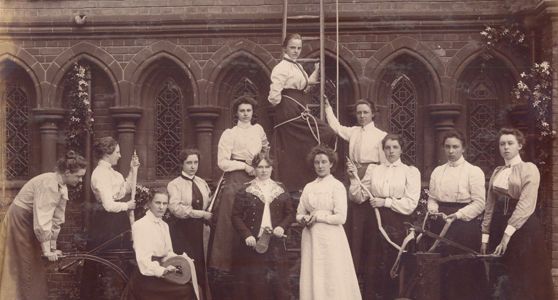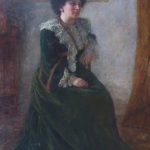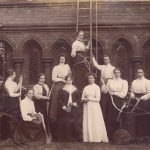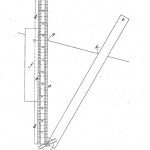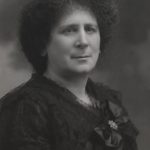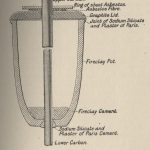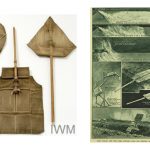The life and material culture of Hertha Marks Ayrton (1854-1923): suffragette, physicist, mathematician and inventor
Abstract
https://dx.doi.org/10.15180/181002/001Suffragette, physicist, mathematician and inventor: in the late nineteenth and early twentieth century when few women had access to opportunities in science, technology, engineering and mathematics (STEM), Englishwoman Hertha Marks Ayrton held all these roles and was a strong advocate for social justice, especially suffrage for women.
Using material from the Science Museum archives, this paper explores the material culture of Ayrton’s career and work and provides an insight into issues and intersections of gender, science, and technology in the late nineteenth and early twentieth centuries. The article engages with the material culture of Ayrton’s work across multiple fields in STEM. Firstly, it discusses the line-divider, a mathematical tool and engineering drawing instrument Ayrton developed while still an undergraduate at Cambridge and later patented. This was the first of twenty-six patents Ayrton was granted during her lifetime. Next, the paper turns to the electric arc. Ayrton made notable contributions to the understanding of this early and powerful form of electric lighting, and quite literally published the textbook on it. Thirdly, the paper looks at the ‘Ayrton anti-gas fan’, which was distributed in thousands and used to dissipate gas in the trenches on the Western Front during the First World War.
Lastly, this paper will explore the impact of gender on Ayrton’s achievements and recognition. Ayrton was elected the first female member of the Institution of Electrical Engineers (IEE), the premier British institution of electrical and electronic engineering, in 1899. However, her nomination as a Fellow of the Royal Society (FRS) in 1902 was declined because of her gender.
Keywords
electric lighting, electrical engineer, First World War, Hertha Ayrton, mathematics, scientific instruments, Suffragette
Introduction
https://dx.doi.org/10.15180/
Suffragette, physicist, mathematician and inventor: in the late nineteenth and early twentieth century when few women had access to opportunities in science, technology, engineering, and mathematics (STEM), Englishwoman Hertha Marks Ayrton held all these roles and was a strong advocate for social justice, especially suffrage for women.
Born into a relatively poor immigrant family, Ayrton accessed education through the support of better-off family members and the wider suffrage community. Her original field of study was mathematics, which she studied at Cambridge, and her first invention and patent was for a line-divider, a mathematical tool and engineering drawing instrument, which she developed while still a Cambridge undergraduate. Ayrton patented the device after she graduated in 1884 and it was the first of twenty-six patents she was granted during her lifetime.
In 1885 Ayrton began attending evening classes and studied electricity and physics at Finsbury Technical College in London. Thereafter, she made notable contributions to the development and understanding of the electric arc, an early and powerful form of electric lighting. Her research interests were broad and she also researched water and air vortices resulting in a life-saving application, the ‘Ayrton anti-gas fan’, which was used to clear poisonous chemical gases from front line trenches during the First World War.
Ayrton made an immense and diverse contribution to mathematics, physics and electrical engineering. Her incredible life can be illuminated by three key artefacts: the 1884 patent for her line-divider; her article series on the electric arc published in The Electrician in 1895; and the ‘Ayrton anti-gas fan’ developed to combat trench gas during the First World War. Spanning four decades and three subject areas – mathematics, electrical engineering and physics – these accomplishments demonstrate the deep impact Ayrton had on these specialist technical and scientific subjects as well as on the emerging roles available to women in engineering.
The fight for recognition of Ayrton has continued beyond her death: it is only recently that scholarship in the history of technology and electrical engineering has begun to acknowledge the roles available to women in these fields, past and present (Barrett, 2017; Gooday, 2008; Fara, 2018; and Jones, 2009), and how women in these fields have been ignored and sometimes written out of history (Hicks, 2017; Saini, 2018). Contemporaneous publications choose to focus on the mostly commercial activities of engineer-innovators who were almost entirely male. Using material from the Science Museum archives, this paper explores the material culture of Ayrton’s career and work and provides an insight into issues of gender, science and technology in the late nineteenth and early twentieth centuries, through to the First World War and beyond.[1]
Living and learning: Ayrton’s early educational opportunities
https://dx.doi.org/10.15180/181002/002One of the distinctive elements in Ayrton’s life was that, from an early age, her family and friends actively supported and encouraged her pursuit of education without conditions.[2] Born Phoebe Sarah Marks in Portsea, Hampshire, England in April 1854, she was the third of eight children of a seamstress, Alice Theresa Marks (née Moss), and a Polish Jewish watchmaker and jeweller, Levi Marks (Mason, 2004; Sharp, 1926, 3). It is said by her (sole) biographer, Evelyn Sharp, that Sarah (as she was then known) inherited her mechanical ability from her watchmaker father (Sharp, 1926, 1-2). Ayrton’s father died in 1861 when she was seven years old leaving his family penniless. Her mother returned to her work as a seamstress and taught her family self-sufficiency and generosity, two values Ayrton continued to live by throughout her life.
Two years later when Ayrton was nine, she was invited by her maternal aunt Marion Hartog, who ran a school in north-west London with her husband Alphonse Hartog, to live with her cousins and to be educated with them. Despite the personal hardship, Ayrton’s mother Alice recognised her daughter’s immense intellectual abilities and talents and supported the move to London as it provided increased access to education and further opportunities. It was through her cousins that Ayrton was introduced to science and mathematics and by the time she was sixteen, she was living independently and working as a governess.
It was around this time that Ayrton became friends with the family of Karl Blind, Jewish-German émigrés, and it was their daughter Ottilie Blind who nicknamed Ayrton ‘Hertha’ after Algernon Swinburne’s poem of the same name (Mason, 2004). Ottilie Blind and Ayrton became lifelong friends and together they attended suffrage meetings and coached each other for the Cambridge University entrance examination for women in 1874, in part due to the paucity of evening lectures or classes open to women at this time (Sharp, 1926, 26-29). In 1873, Ottilie Blind introduced Ayrton to the woman who would be perhaps Ayrton’s most significant mentor, the outspoken feminist, Barbara Bodichon.
Bodichon’s friendship with Ayrton marked a new epoch in Ayrton’s life, providing access to university education and all the related opportunities this entailed. In 1869 and four years prior to meeting Ayrton, Bodichon has been one of the main founders of Girton College, Cambridge. Girton was England’s first residential college for women and Cambridge’s sole all-female college. Bodichon encouraged Ayrton to apply to Girton College and also introduced her to the novelist George Eliot (Mary Anne Evans), another feminist and supporter of education for women who personally supported Ayrton’s application to Girton College. Eliot and Ayrton became friends and it is said that the character Mirah in Eliot’s final full novel Daniel Deronda published in 1876 bears a strong resemblance to Ayrton.
Ayrton was determined to study at Cambridge University, despite the fact that the university did not award degrees to women. In 1874, Ayrton passed the Cambridge University Examination for women with honours in English and Mathematics, having prepared for the entrance examinations alongside her lifelong friend Ottilie Blind. In 1876, Ayrton sat the Girton scholarship examinations but did not receive either of the two scholarships on offer (Ogilvie, 1990, p 33). Lacking in personal and family wealth, Ayrton would have been unable to afford the £92 a year required to study at Girton without working. Instead she was supported by a loan from fellow suffragette Helen Taylor of £25 per year with Bodichon, George Eliot and Lady Sophia Goldsmid, amongst others, contributing the remaining sum (Crawford, 2000, p 22). In October 1876, Ayrton entered Girton to study mathematics (James, 2010, p 106).[3]
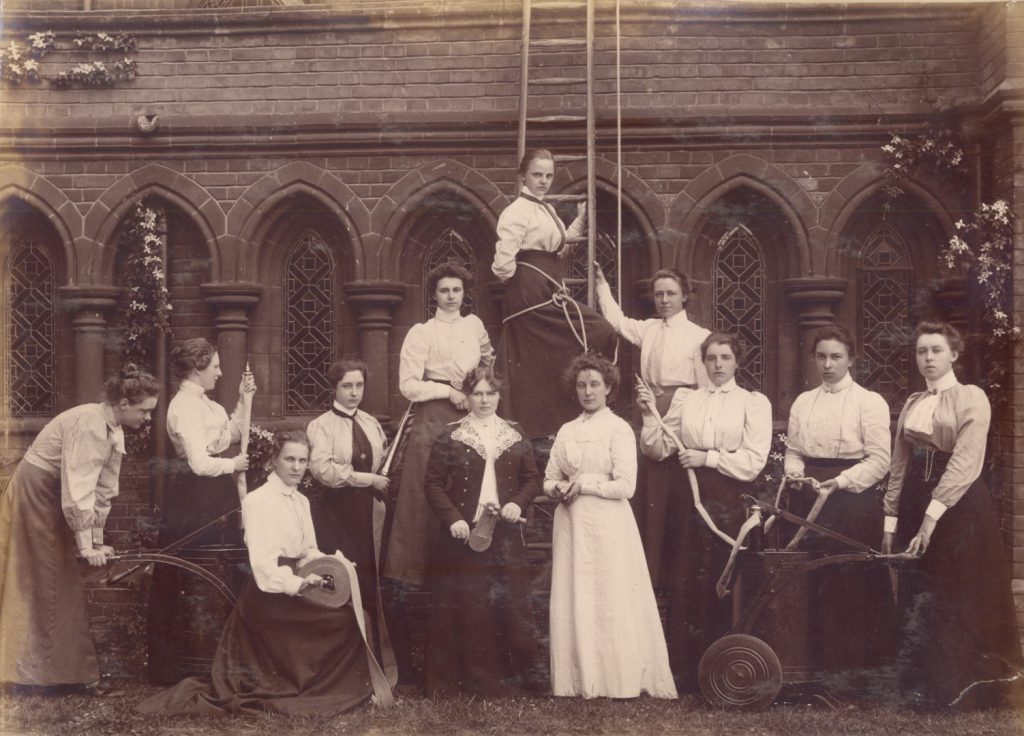
While at Girton, Ayrton was coached (albeit inconsistently) in person and by letter for the Mathematics Tripos by Richard T Glazebrook, one of the most prominent English physicists of his age and an FRS, who she described as ‘a jewel of a lecturer’ (Sharp, 1926, p 75). In 1880, Glazebrook was appointed a demonstrator at the Cavendish Laboratory when Lord Rayleigh became Cavendish Professor in the same year, switching his attention from mathematics to electrical demonstrations, and he began to tutor Ayrton by letter from then onwards.[4] Around this time, Ayrton also began her earliest work on scientific and medical instruments, designing and constructing a sphygmomanometer, an instrument for recording the pulse in arteries. Ayrton was also an active member of the Girton College community: she was leader of the College Choral Society and founded the college fire brigade (Mason, 1991, p 202; Mason, 2004). Ayrton also formed a mathematics club with fellow mathematician Charlotte Scott, who received special permission in 1880 to become Girton’s first wrangler (a Cambridge undergraduate in mathematics who obtains first-class honours in their third-year exams) but she was left out of the formal Tripos (undergraduate examination) results because of her gender (Jones, 2009, pp 8–39).
In 1880, Ayrton passed the Mathematical Tripos with only a third-class performance, in part the result of regular bouts of illness. The Mathematical Tripos was the elite degree for English gentlemen for much of the nineteenth century and was considered rigorous and physically demanding. The Mathematical Tripos varied over the nineteenth century but generally consisted of hundreds of testing questions taken in back-to-back examinations. It lasted around a week and such was the rigour that a few students in the nineteenth century died shortly after completing the examinations (Forfar, 1996). As such, it was of special significance for female students and was targeted by campaigners in order to demonstrate women’s intellectual equality with men (Jones, 2009, pp 147–165).
However, Ayrton was not granted a certificate or degree. At this time, Cambridge did not give degrees to women and would only award certificates to women in 1881, the year after Ayrton finished at Cambridge (Mason, 1991, p 217). Ayrton successfully completed an external examination and in 1881 she returned to London and received an external BSc degree from the University of London, one of the few British universities who granted degrees to women during this period and which provided a well-worn path for those who graduated from non-degree-awarding institutions at this time. It was upon her return to London that Ayrton began to consider further developing and patenting her first invention, a line-divider, which she began working on while a student at Girton. This would be the beginning of a prolific patenting and inventing career. Over her lifetime, Ayrton was granted twenty-six patents: five on mathematical dividers, thirteen on arc lamps and electrodes, and eight relating to the propulsion of air.
Dividing and conquering: Ayrton’s line-divider patent in 1884
https://dx.doi.org/10.15180/181002/003Upon her return to London in the early 1880s, Ayrton supported herself by teaching and tutoring mathematics but also began to consider ways of earning a living including patenting her inventions. In March 1884, Ayrton was granted British patent 5543 Improvements in Mathematical Dividing Instruments for her line-divider, an engineering drawing instrument for dividing a line into any number of equal parts and for enlarging and reducing figures.[5] Ayrton had been inspired by the illustration of a drawing instrument made up of a series of parallelograms, provided to her by her cousin Ansel Leo in February 1883. Almost instantly, Ayrton saw the weaknesses in the idea and set about improving it in collaboration with her cousin. However, their joint work came to nothing and it was a new line-divider design, invented and designed solely by Ayrton, which resulted in her March 1884 British patent as well as her later US patent, granted in January 1885 (Sharp, 1926, p 107; Jaffé, 2003, pp 120–121).
Ayrton’s British patent application was financially supported by Lady Goldsmid and Bodichon, who together advanced her enough money to take out her British patent as well as foreign patents. A couple of months after receiving her British patent, Ayrton turned down an Easter trip abroad with Bodichon to take out foreign patents for her line divider, including an application for a US patent for the device. Now described as a ‘Draftsman’s Dividing Instrument’, it was filed on 3 May 1884 and granted on 6 January 1885.[6] Whether Ayrton exploited her US patent or not remains unknown.
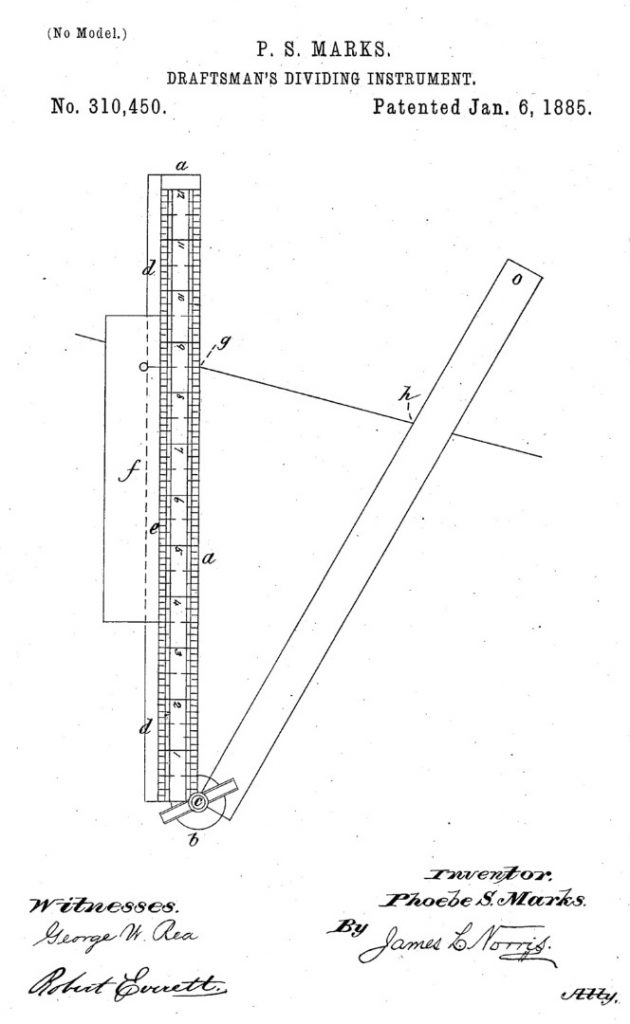
The line-divider was Ayrton’s first major invention and, while its primary use was likely to be for artists for enlarging and diminishing images, it was also useful to architects and engineers and was afforded a favourable reception by artists, architects and engineers alike (James, 2010, p 107; Tattersall and McMurran, 1995). The line-divider received many positive reviews in the scientific press. A Nature review of the line divider in January 1885 concluded that it was ‘…a very handy instrument for architects, engineers and practical drawing…’ and a review in the Academy warmly observed that the line-divider was advantageous ‘to all those who have to do with the line and the rule’ (quoted in Sharp, 1926, p 108; 1885a).[7] It would appear that one of the foreign patents applied for by Ayrton was French as the line-divider also received a good reception in the Paris-based periodical Revue Scientifique. On 14 May 1885 it noted that the instrument was invented by a Girtonian and concluded: ‘L’on a souvent prétendu que la femme n’est capable que d’assimilation et non d’invention: l’appareil que nous venons de décrire est une preuve mathématique du contraire.’ (‘It has often been asserted that women are only capable of assimilation and not of invention; the apparatus we have just described is a mathematical proof to the contrary’, quoted in (Sharp, 1926, p 109) translation author’s own).
On 14 February 1885, Ayrton (credited as Sarah Marks) read a paper before the Physical Society entitled ‘The Uses of a Line-Divider’ which described the many uses of her patented line-divider and which was also re-printed in the Philosophical Magazine (Marks, 1885a; Marks, 1885b). Towards the end of her well-illustrated seven-page paper, Ayrton expanded upon the uses of the line-divider:
The divider would also be useful on board ships for drawing lines on charts parallel to other lines at some distance. It would be much better for this purpose than an ordinary parallel ruler on account of its very large range and capability of being fixed.
The device was manufactured and sold by W F Stanley and Company of Great Turnstile, Holborn, London, an engineer and specialist maker of scientific and mathematical instruments, and was available in three lengths: six, twelve and twenty-four inches in length.[8] The device was also shown at the Loan Exhibition of Women’s Industries held in Bristol from February to April 1885 and organised by Anglo-Irish suffragist Helen Blackburn (1885b).[9]
In the aftermath of the success of her line-divider and with increased confidence, Ayrton’s supporters suggested that she become an entrepreneur and start her own business as an inventor and manufacturer of mathematical instruments (Wynarczyk and Jaffé, 2011, p 11). Instead, Ayrton began to seriously consider a scientific career and, to this end, in 1884 she began to attend evening lectures four nights a week as a special student at Finsbury City and Guilds Technical College, the first technical college in England. Ayrton studied electro-technics (electricity and physics) at the college where she was just one of three women studying alongside 118 men (Jones, 2010). Here Ayrton was taught by physics expert, renowned electrical engineer, and FRS Professor William Edward (Will) Ayrton, then Professor of Applied Physics of the City and Guilds of London Institute, of which Finsbury Technical College was a subsidiary.[10] A year after they met, they were married on 6 May 1885 and another year later in 1886 they had a daughter, Barbara Bodichon, named after Ayrton’s mentor and supporter.
Ayrton’s new husband William Ayrton was a widower with a young daughter (Edith) and was very supportive of women’s education and legal rights. With marriage came relief from the financial worries that had plagued Ayrton’s early life and after settling down to married life, Ayrton resumed her scientific research working from a laboratory in the family home. In 1888, Ayrton began teaching classes on practical and domestic electricity to women but the combination of her domestic responsibilities and young daughter meant Ayrton had little time for further research and work.
In 1891, Ayrton’s mentor and her daughter’s namesake Barbara Bodichon died. Ayrton was greatly upset and grieved deeply for years afterwards but there was a positive outcome: Barbara left Ayrton a sum of money which enabled Ayrton to support her ageing mother and to hire a housekeeper so that she might dedicate more time and energy to her research. In the early 1890s, Ayrton began researching the properties of electric arcs. At first, she began by assisting her husband with his research but soon she took over the research herself.
Arc angel: Ayrton’s research on electric arcs in the 1890s
https://dx.doi.org/10.15180/181002/004
Arc lighting was developed in the early to mid-nineteenth century and by the mid-nineteenth century had found a use as the powerful light in lighthouses. By the late nineteenth century, direct-current electric arcs were widely used for public lighting and were replacing gaslights as street lighting. As such, electric arcs were of significant industrial, commercial and physical interest. However, the electric arc lighting systems of this time were temperamental and prone to problems: they flickered, hissed, rotated, and produced unsteady and inconsistent lighting. There were also further difficulties with the materials used: the intense heat produced made for excellent, large-scale public lighting but also made it difficult to manufacture insulators and design electrodes capable of dealing with the intense heat. Some research had been done into electric arcs but much of their operation and underlying principles remained unknown and so scientists were unable to advise manufacturers as to the best way to design and operate such lights.
In 1893, William Ayrton travelled to the Chicago Electric Congress to present the results of his research on electric arcs. William left the sole copy of his paper with the Secretary for publication but instead it was accidentally used as kindling for a fire (Ayrton, 1902, vi). No rough copy or abstract remained of the paper and while William was in the US attending the congress, his experiments, which were being conducted at South Kensington, were left under Ayrton’s supervision (Trotter, 1924). When William returned he had no inclination to rewrite the paper and so Ayrton took over the experiments previously conducted by her husband, at first replicating his research but quickly moving beyond it. Her husband moved onto other areas of research as he was keen not to be credited with his wife’s work.
Ayrton established two key points in relation to the working of electric arcs. Firstly, she discovered that the problems with electric arc lighting such as hissing, flickering and instability were the result of oxygen coming into contact with the carbon rods used to create the arc (Mason, 2004). Secondly, Ayrton discovered that when oxygen was excluded, a steady arc was obtained and hence she was able to establish a linear relationship between arc length, pressure, and potential difference, the ‘Ayrton equation’. Ayrton used her knowledge of electric arcs to patent a number of improvements in anti-aircraft searchlight carbons, which she developed for the British Admiralty; she also designed improved cinema projectors and more general arc lamp technology.
Between 1895 and 1896, Ayrton published a series of twelve articles on her analysis, research and technical advances in the field of electric arc lighting – commonly used for street lighting and powerful interior lights – in The Electrician, the premier electrical engineering periodical of the age. With these articles, she overtook her husband’s earlier work in this field and established her own credentials as an expert on the workings of the electric arc and in the field of electrical engineering more generally. This recognition led to increased opportunities including the invitation to deliver her own paper on electric arcs before the Institution of Electrical Engineers (IEE). She was the first woman to read her own paper before this prestigious engineering society, although the society was more progressive than many of their peers and had allowed women to attend their lectures since the institution was founded as the Society of Telegraph Engineers in 1871. In all of this, Ayrton was achieving rare progress for a woman but was also establishing a path which other women in science, technology, and engineering might and would follow.
Three of Ayrton’s earliest papers on electric arcs were delivered before the annual meetings of the British Association for the Advancement of Science (BAAS, now the British Science Association) in 1895, 1896 and 1898. All three papers were delivered before Section A – Mathematical and Physical Sciences and the two earliest papers were delivered immediately adjacent to papers of Ayrton’s husband, who was heavily involved in the BAAS. Ayrton was also a member of the ‘Brit. Ass.’, as it was affectionately known (Barrett, 2017, p 210). In 1895, Ayrton delivered a paper on ‘On the Equation Connecting the Potential Difference, Current, and Length of the Electric Arc’ for which no further details were provided in the report of the sixty-fifth annual BAAS meeting. The paper was presented immediately before a paper by Ayrton’s husband with T Maher, ‘On the back EMF and True Resistance of the Electric Arc’ (1895).[11] In 1897, Ayrton presented a paper ‘On the Relations between Arc Curves and Crater Ratios with Cored Positive Carbons’ before the BAAS annual meeting held at Toronto, Canada that year (the BAAS held every fourth meeting abroad). Again, Ayrton presented immediately adjacent to her husband: this time William Ayrton presented jointly with Professor J Viriamu Jones, FRS with a paper on ‘On a Determination of the Ohm made in Testing the Lorenz Apparatus’ (1898).[12]
In 1898, Ayrton presented a third paper on electric arcs before the BAAS annual meeting, this time held in Bristol. In her paper ‘The drop of potential at the carbons of the electric arc’, Ayrton described her research into the constancy of the drop of potential at the carbons of the electric arc and noted that she hoped to find a more conclusive answer in her future research (1899).[13] By now, Ayrton appears to have a found a new independence and confidence in the public presentation of her research: she no longer presented immediately adjacent to her husband and also submitted an abstract for the paper to The Electrician for publication; a corrected and annotated proof in Silvanus Thompson’s hand is held by the IET archives.[14] Ayrton’s papers before the BAAS were, in part, enabled by women being able to serve on the BAAS general and sectional committees and marked a changing relationship between the learned society and women, both as producers and consumers of scientific research and content (Baxter, online).[15]
The following year in March 1899, Ayrton’s research and expertise, in particular that related to the electric arc, were recognised by the IEE: Ayrton was invited to give a paper before the IEE and she was elected a member of the institution (MIEE), a prestigious and widely recognised professional qualification. On 23 March 1899, Ayrton read a paper ‘The Hissing of the Electric Arc’ before the IEE which summarised her research into the sometimes eccentric behaviour of electric arcs. The paper and the post-paper discussion were published in the Journal of the Institution of Electrical Engineers (Ayrton, 1899).

Just two days after she delivered her paper, Ayrton was elected the first female member of the IEE, which then consisted of 3,300 members (Sharp, 1926, p 141). Ayrton remained the sole female full member of the institution until 1958, although Gertrude Entwisle became a student, graduate and associate member of the institution in the 1920s. Additionally, in March 1899, Ayrton was awarded an IEE premium (prize) to the value of £10 for her IEE paper on electric arcs. This was formally presented to her at the society’s annual general meeting the following November at which the new President, Silvanus Thompson, gave his inaugural address. Ayrton was in good company: among her fellow recipients of IEE premiums that evening was Guglielmo Marconi, for his paper ‘Wireless Telegraphy’, and Professor Oliver Lodge for his paper (also on wireless telegraphy), ‘Improvements in Space Telegraphy’.
In post-lecture correspondence with fellow electrical engineer Dr Silvanus P Thompson in late May 1899, Ayrton noted that she had received a copy of A P Trotter’s contribution to the post-lecture discussions.[16] Ayrton mentioned, in passing, Thompson’s Cantor Lecture, delivered a few months previously before the Royal Society of Arts, about the electric arc. Perhaps it was only in passing because her equation of the relationship between current and voltage disagreed with that of Thompson (Hong, 2001, p 162). The main focus of her letter to Thompson was to clarify that ‘while it was impossible that the slowly rotating figures should not have been observed before, but that [she] could find no description of [these] figures’ and that these figures observed from her electric arcs made in her laboratory had not been described by Thompson in his Cantor Lecture.[17] Ayrton lamented that she was unable to show Thompson ‘the clearly defined & comparatively slowly moving light & dark bands’ as she had been too busy since her IEE lecture in late March to get the apparatus in working order again.[18]
By the late nineteenth century, Ayrton’s work in the field of electrical engineering began to be recognised more widely – domestically and internationally. In 1899, Ayrton presided over the physical science section at the International Congress of Women held in London and she was invited by the Royal Society to demonstrate her electric arc experiments at their annual conversazione (Byers and Williams, 2006, p 17). In 1900, she delivered a lecture in French about her electric arc research, L’intensité lumineuse de l’arc à courants continus (‘The luminous intensity of the direct-current arc’), at the International Electrical Congress in Paris.[19]
Her lecture was used by her cousin Marcus Hartog to persuade the British Association for the Advancement of Science to allow women on their committees (Mason, 2004). In 1901, her paper ‘The mechanism of the electric arc’ was delivered before the Royal Society by renowned electrical engineer Professor John Perry (Ayrton, 1901). Perry was an electrical engineer, former Professor of Engineering and Mathematics at Finsbury Technical College and had collaborated with William Ayrton for a number of years. Perry delivered Ayrton’s Royal Society paper as women were still unable to present papers before this prestigious and traditional scientific society.
In 1902, Ayrton published The Electric Arc, a comprehensive summary of her research and work on the electric arc, with origins in her earlier articles from The Electrician published between 1895 and 1896 (Ayrton, 1902). The title page was where the author laid out their qualifications and expertise. Here it said simply ‘Hertha Ayrton, Member of the Institution of Electrical Engineers’; no further qualification was needed. The Electric Arc, which remains in print into the twenty-first century, became the standard textbook on the subject until after the First World War and firmly established Ayrton’s reputation in electric arc lighting as well as electrical engineering.
Despite these many achievements in physics and electrical engineering, Ayrton remained marginalised by more traditional scientific societies such as the Royal Society and, with the exception of the IEE and the support of her husband, an outsider in the scientific community. In the aftermath of the publication of The Electric Arc in 1902, Ayrton was proposed as an FRS by Professor Perry (who had read Ayrton’s paper before the Royal Society a year previously in 1901) and other prominent scientists and Royal Society council members. The Society’s council were divided on the issue: then Royal Society President and astronomer William Huggins was against women ‘trivialising’ his elite scientific institution and Ayrton’s increasingly outspoken commitment to women’s suffrage probably did not help matters (Jones, 2010). However, officially Ayrton’s application was turned down by the Council of the Royal Society based on legal advice that married women were ineligible to be Fellows of the Royal Society as they had no independent legal standing in law.[20]
Nonetheless in 1904 (and in the temporary absence of William Huggins) Ayrton became the first woman to deliver her own paper, ‘The Motion of Ripples in Sand and Wave’, before the Royal Society. She delivered further papers on this subject before the Royal Society, published in 1908 and 1910 (Ayrton, 1908; Ayrton, 1910). In 1906, Ayrton was awarded the Royal Society’s Hughes medal which was granted ‘without restriction of sex or nationality […] for an original discovery in the physical sciences, particularly as applied to the generation, storage and use of energy’ in recognition of her work on the electric arc and her later research on the motion of ripples in sand and water.[21] Although the Royal Society was a conservative and restricted institution – as indicated by their denial of the full participation of women for much of the twentieth century – the Hughes medal was prestigious within and without the society and eligibility for it was defined in progressive terms as being ‘without restriction of sex or nationality’. Despite these claimed lack of restrictions, Ayrton was the first woman awarded this prestigious medal: a rare achievement considering the gendered spaces she was working and not working in. Unlike her male scientific peers, Ayrton did not have access to any institutional laboratory in her own right and instead relied on the use of her husband’s laboratory at the Central Institution in London (now Imperial College), until his death in 1908 (Jones, 2010).
Nonetheless, Ayrton continued with her research and further developed theories informed by her body of experimental work, presenting before British and international audiences. In 1911, Ayrton travelled to Paris where she presented a paper on ‘Sand Ripples and Oscillating Water’ before the Société de Physique.[22] Ayrton began her paper, which summarised her experiments on, and theories of, the formation of ripples in sand and waves in water, with compliments to her audience of ‘distinguished and brilliant…scientists… Frenchmen [who] make the kindest and most indulgent audience in the world’.[23] Ayrton concluded her paper with a consideration of how her research on the formation of ripples would apply to propellers and aircraft adding an ‘urgent plea’ for mathematicians to take into consideration her research and theories and to modify their theories, in particular in hydrostatics, accordingly.[24]
While in Paris in 1911, Ayrton also visited Marie Curie and would always visit her when she came to the French capital. The two women of science first met during a visit by the Curies to the Royal Institution in London in 1903 after they won the Nobel Prize for Physics. Here, the two women became good friends and they had many shared commonalities: being part of a married collaborative couple; an independent dedication to scientific research, which both pursued against their social origins and gendered expectations of the time; and a strong sense of social justice especially for women (Ogilvie, 2011, pp 123–125). Such was the strength of their friendship that Marie Curie presented Ayrton with an author’s presentation copy of her 1903 thesis with the dedication, ‘A Madame Hertha Ayrton / Hommage d’une sympathie tres sincere / M. Curie’ (‘To Madame Hertha Ayrton/ in truly sincere homage / M.Curie’), now held by the IET library and archives.[25]
Ayrton’s visit to Paris in 1911 was particularly notable as, almost simultaneously in November 1911, Curie received her second Nobel Prize in Chemistry – for the discovery of radium and polonium – and her affair with fellow physicist and colleague Paul Langevin (who was married) was publicly revealed (Goldsmith, 2006).[26] Later on in the summer of 1912, Curie secretly came to England with her daughters Irene and Eve and stayed with Ayrton for two months at a coastal English cottage when Curie needed somewhere to escape the brief scandal concerning her relationship with Langevin (Hemmungs Wirten, 2015, p 76). Ayrton was not the only the member of the scientific community to publicly support Curie when revelations of the affair came to light to much public criticism: Albert Einstein wrote a friendly and supportive private letter to Curie, expressing his admiration for ‘[her] intellect, [her] drive, and [her] honesty’ and considered himself lucky to have made her personal acquaintance at the 1911 Solvay Conference in Physics in Brussels.[27]
It would seem that Marie Curie, and the audience of French physicists to which Ayrton was so highly complimentary, provided a more welcoming audience than that of the British scientific establishment as represented by the Royal Society. Ayrton had, in turn, been an out-spoken champion and supporter of Curie when, after her husband’s death in 1909, Pierre Curie and not Marie Curie was claimed as the discoverer of radium, including by the British press. Perhaps reflecting on her personal experience of her scientific successes being attributed to her husband, Ayrton wrote a letter to the Westminster Gazette on 14 March 1909, noting ‘Errors are notoriously hard to kill, but an error that ascribes to a man what was actually the work of a woman has more lives than a cat’ (quoted in Sharp, 1926, p 117).
Between 1911 and 1913, Ayrton was kept busy with the suffragette movement, marching on many if not all of the most militant suffrage marches in London. She also continued her research into the scientific and mathematical understanding of motion of ripples in sand and motion, including a paper on the topic ‘On some new facts connected with the motion of oscillating water’, presented before the Royal Society in 1911. The paper was delayed from November 1910 to late January 1911 due to Ayrton’s involvement in the suffrage marches at this time and Ayrton felt her public involvement in these marches was the reason the paper was not published (Abir-Am and Outram, 1987, p 122 footnote 53). This was contradicted by a detailed three-page anonymous Royal Society reviewer’s comments about Ayrton’s paper which noted:[28]
Mrs Ayrton’s paper is rather difficult to criticise. She has brought to light a number of interesting facts and exhibited them in a very beautiful way, but the reasoning throughout appears defective. The essential fallacy has its source in treating the motion at any instant as if the water were at rest, and consequently neglecting the effect of the rate of change of momentum. […]
Despite the setback in terms of publication of her research, Ayton continued her experiments which led to further research on oscillations in water and air, a research topic she continued to pursue throughout the war years and one which had immense practical application in the First World War.[29]
Quite a flap: the development of the 'Ayrton anti-gas fan' during the First World War
https://dx.doi.org/10.15180/181002/005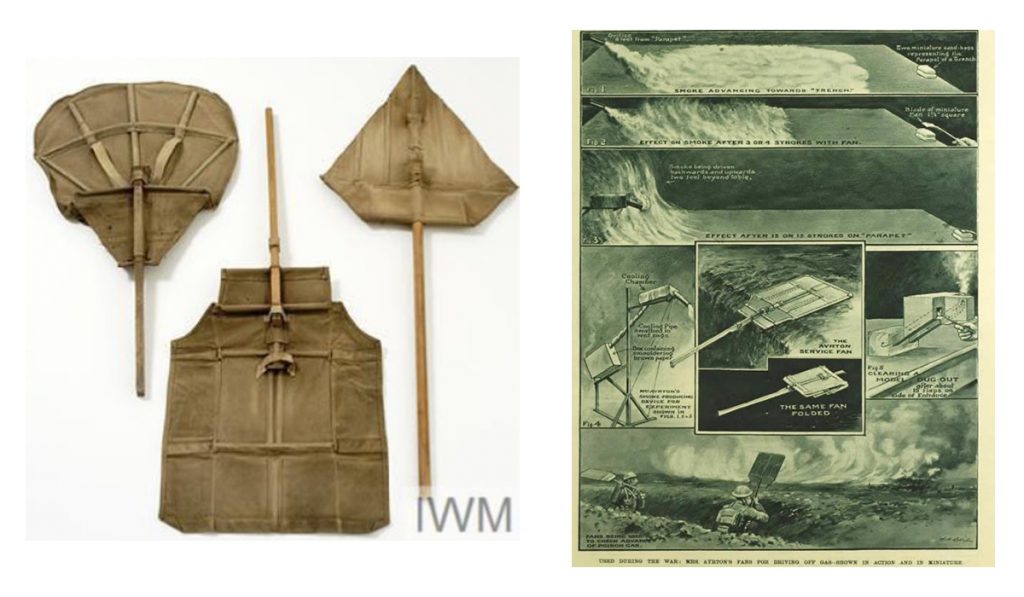
After the German Army first used poison gas at the Second Battle of Ypres in April 1915, many British scientists quickly began to adapt their research to counteracting this new and deadly weapon. In early May 1915 and shortly after the news of German use of gas had reached England, Ayrton presented a paper on differences in pressure near obstacles in moving water and began to consider how this might have practical application in terms of removing gas from the trenches (Ayrton, 1915). She described her device, a fan which became known as the ‘Ayrton anti-gas fan’ in detail in a paper before the Royal Society in 1919. The fan provided an obstacle which created a vortex of air and pushed poisonous gas out of the trenches and back towards the enemy (Ayrton, 1919). Ayrton’s anti-gas fan was simple and consisted of a sheet of waterproof canvas supported and stiffened by a frame of cane and held by a hickory handle. At first, Ayrton tested the principle of the idea through experiments with burning brown paper in her drawing room laboratory; by mid-May 1915 she had developed a working model which she tested out in her friend and fellow suffragette Ernestine Mill’s back garden in Kensington (Crawford, 2000, p 23).
The War Office initially dismissed her invention and passionate exchanges were made publicly in the press until May 1916 when the War Office relented and granted Ayrton the opportunity to demonstrate the device. An assistant and one of her colleagues from the Central College, a Mr Greenslade, organised tests of the fans and trained soldiers in how to use them (Ayrton, 1919, p 256). Meanwhile, Ayrton herself arranged their production. Initial examples made in 1916 had severe operational limitations: they were only effective in winds less than nine miles an hour and had to be operated manually.[30] By 1917 Ayrton’s adapted version of the fan, now mechanically operated and resistant to high winds, was ready but Ayrton faced continued opposition from the War Office as well as bureaucratic delays. However, with the support of A P Trotter, a fellow electrical engineer and member of the IEE who had contacts in British military command, the Ayrton anti-gas fan was soon being used on the Western Front with an eventual total order of 104,000 fans (Hirsch, 2009). Ayrton anti-gas fans were used to clear trenches, dug-outs and shell holes, and mine craters of poisonous gases.
In 1920 and possibly in advance of submitting a claim to the Royal Commission on Awards to Inventors (RCAI) for financial compensation for her ‘Ayrton anti-gas fans’, Ayrton described her invention and its development in The Times and complained about official apathy to her and others’ scientific endeavours and the delay in supplying her device to frontline troops:
On May 6, 1915, I conceived the idea that it might be possible for our men to drive off poisonous gases and bring in fresh air from behind by simply giving impulses to air with hand fans. By May 14, I had made a small model, giving surprisingly good results, and I wrote to the only authority at the War Office I knew at all, to offer it to the army.[31]
The day after Ayrton’s article was published, a letter of support from Major H J Gillespie, formerly of the Royal Field Artillery, who had introduced the Ayrton anti-gas fan into the Army and onto the Western Front was published. This praised the invention and noted the time it took the Army and War Office to evaluate, manufacture, and then introduce such devices onto the frontline.[32] A few days later on 6 May 1920, one Major Sisson, formerly of the Royal Engineers, wrote to The Times observing that responsibility for turning down the Ayrton anti-gas fan lay with the British Army in France and not the War Office: ‘the fans were given up because prolonged experience in the field showed that they served no useful purpose for defence against gas.’[33] The debate, albeit limited, surrounding the Ayrton fan may have led Ayrton not to submit a claim to the Royal Commission on Awards to Inventors (RCAI), founded to allocate credit and some compensation for wartime technical innovation and contribution. Instead, Ayrton’s sole claim to the RCAI was for the Admiralty’s use of her negative carbon searchlight arc system; the claim was not completed until after Ayrton’s death in August 1923 and so the final claim in 1924 was made by Ayrton’s Executrix, her daughter Barbara Ayrton Gould.[34]
Nonetheless, Ayrton continued to work in the field of vortex studies until her death in August 1923: one of two partially-filled research notebooks on Ayrton anti-gas fans contains notes on final experiments conducted in early June 1923.[35] The second notebook entitled ‘Thoughts on Fans’ is barely filled and seems to have been abandoned sometime in late 1918, most probably after war had ended. Meanwhile a notebook begun earlier – in July 1918 – on using motor-driven fans to apply the ‘Flapper Principle’ to tubes reveals the practical application to which Ayrton wished to apply the Ayrton anti-gas fan in the post-war years. To this end, Ayrton anti-gas fans were later adapted to improve ventilation in mines, sewers and industrial sectors.[36]
Suffragette sisters: Ayrton, gender and the suffrage movement
https://dx.doi.org/10.15180/181002/006Much of Ayrton’s achievements and successes were the result of the support she received early in her life from an active community of women, feminists and suffragettes. From an early age, Ayrton was supported by her family who enabled her to continue her education until she was sixteen. When she began to consider a further, university education, Ayrton was supported by feminist Barbara Bodichon and a number of her friends including George Eliot and Lady Goldsmid. These women provided financial support for Ayrton’s university education at Cambridge as well as her first patent application in 1884. Ayrton herself was a fighter for social justice, in particular the rights of women, from an early age and was heavily involved in the suffragette movement. She was an active member of the Woman’s Social and Political Union (WPSU): Ayrton and her daughter both joined in 1907 and Ayrton made regular financial contributions to the organisation (Crawford, 2000, p 23).
Ayrton and her daughter both regularly participated in various suffrage rallies between 1906 and 1913. Ayrton was also a founding member of the International Federation of University Women (founded in 1919) and the National Union of Scientific Workers (founded in 1920); she also served as vice-president of the British Federation of University Women and vice-president of the National Union of Women’s Suffrage Societies (Tattersall and McMurran, 1995, p 107). In her role as a public and respected figure, Ayrton’s support for social justice was invaluable to this cause. Although it took valuable time away from her scientific research, Ayrton devoted increasing time to women’s and social causes particularly in her later years.
Gender is an illuminating lens through which to view Ayrton’s work and recognition. Ayrton was most probably the first female professional electrical engineer and was elected the first female member of the Institution of Electrical Engineers (IEE) in recognition of her research and work in electrical engineering, particularly electric arcs. Ayrton was granted opportunities and advancement few women in her fields of science and electrical engineering would have for another fifty years. However, it was not all success and recognition – the IEE was one of very few professional technical institutions to recognise her work and worth, while in 1902 her nomination as FRS was declined due to her gender. She was, however, the first woman to read her own paper before the society in 1904.
Although she was not directly involved in its establishment, Ayrton was an early member of the Women’s Engineering Society (WES) established in 1919, and she was a keen supporter of increased opportunities for women in science, technology, engineering, and mathematics (STEM). Ayrton’s wartime work as well as her professional status in electrical engineering was an inspiration for the members of WES, an institution that still exists and continues to support women in engineering careers.
Conclusion
https://dx.doi.org/10.15180/181002/007Mrs Hertha Ayrton was I think the first member of the fair, but no longer frail sex, to distinguish herself in the engineering world, though perhaps the woman engineer would not have arrived yet, had not the war, which upset so many masculine traditions, proved that woman was capable of doing many things which had hitherto been considered strictly within the provenience of the more assertive male…
Hertha Ayrton succeeded in establishing and maintaining a career in scientific research and electrical engineering in an age when opportunities open to women in these fields were limited. From her early life of poverty, Ayrton achieved successes as an inventor, experimenter, researcher, patent-holder, educator and suffragette in an age when a woman could rarely be one of these things let alone all of them! She fought the prejudices of her time, in particular those relating to gender: she encouraged fellow female scientists and engineers by example and she worked hard to remove barriers to entry so that other women might follow in her footsteps.
Ayrton’s recognition and achievements were supported by her fellow advocates for social justice, especially women’s suffrage. Ayrton was a fighter for social justice from an early age and was heavily involved in the suffragette movement. She was politically active and engaged and was not afraid to make her views known. She took part in many marches and demonstrations, including the great suffrage processions of 1910 and 1911. Her determination and innate curiosity were applied in equal measures to social justice, politics, mathematics, physics and electrical engineering.
Ayrton was supported by women throughout her lifetime and in turn she was a powerful advocate for the rights and opportunities of other women. Ayrton’s maternal aunt Marion Hartog arranged for her early education in London and argued strongly for the education of women. Ayrton’s application for Cambridge in the mid-1870s was supported by the author Mary Anne Evans, better known by her masculine pen-name George Eliot. Ayrton’s application for a scholarship to Girton College, Cambridge’s all-women college, was supported by Barbara Bodichon, an outspoken feminist and one of the founders of the college (James, 2010, p 106). When the scholarship application was unsuccessful, Ayrton was supported financially by a loan from Bodichon and her friends (James, 2010, p 106). In 1884, Ayrton’s patent for a line-divider was financially supported by Bodichon and women’s education activist and feminist Lady Louisa Sophia Goldsmid; Ayrton named her first daughter Barbara after her mentor and supporter. Furthermore, Ayrton’s biography published posthumously in 1926 was written by feminist journalist Evelyn Sharp (Sharp, 1926).
Ayrton’s incredible life and work offer a fascinating insight into the emerging roles and opportunities available to women in STEM subjects in the late nineteenth and early twentieth century and Ayrton herself was the instigator of and catalyst for many of these changes. Ayrton actively engaged with the scientific and engineering communities with which she worked and was an active member of professional and scientific institutions of her age, in particular the Royal Society and the IEE.
Ayrton’s involvement with the Royal Society was very much the lesser of the two: while she was the first woman to present a paper before the Royal Society and one of the first women to be awarded a prize – the Hughes Prize in 1906 – the support and membership of this society was closed off from her. It was not until 1945, over forty years after Ayrton’s failed FRS nomination, that the first women were elected as Fellows of the Royal Society: crystallographer Kathleen Lonsdale and biochemist Marjory Stephenson (Mason, 1992). Even then, and afterwards, as the number of female Fellows gradually increased, women were not granted full participation of the society as authorship and editorial work for female Fellows did not grow in line with the increase in membership. Thus, female Fellows were denied full participation in the Royal Society (Fyfe and Røstvik, 2018).[37]
In contrast, the IEE was welcoming to Ayrton: she was the first women to be invited to present a paper before the Institution and was their first female member. When Ayrton died in 1923, she left much of her estate to the IEE, the institution that had encouraged and recognised her achievements throughout her career without prejudice or reservation. However, it must be noted that when Ayrton died, the IEE lost their sole female member – the institution had not elected another female member between Ayrton’s election in 1899 and her death in 1923. Another woman would not be elected to full membership until 1958 and so while the IEE was progressive in the case of Ayrton it was not more generally until the mid-twentieth century (Mason, 2004).
In 1999, the IEE organised a programme of events to commemorate Ayrton and the centenary of her membership of the society, co-sponsored by the Newcomen Society. These included a one-day meeting, an evening lecture, and a replication of Ayrton’s hissing arc experiment. In 2015, the British Society for the History of Science (BSHS) launched the Ayrton Prize, a new prize recognising outstanding web projects and digital engagement in the history of science, technology and medicine (Gooday, 2016). More recently, Ayrton has been remembered through a BBC Radio 4 Great Lives episode broadcast in January 2018 and a blue plaque was put up on her birthplace in Portsmouth in February 2018.
Hertha Marks Ayrton was truly an innovator, both technically and in terms of gender. She fought hard against the gender limitations of her chosen profession, sometimes successfully and sometimes not. Her prominent and public roles as a ‘woman scientist’ helped to broaden perceptions of, and opportunities for, women in engineering and science. Ayrton’s work and achievements laid the foundations for the increased opportunities available to women in engineering during and after the First World War and beyond.
Acknowledgements:
Some of the content from this paper appeared in an earlier form as ‘Hertha Marks Ayrton: An electric woman’ in Charman-Anderson, Suw (ed), A Passion for Science: Stories of Discovery and Invention (2nd edition) (Great Britain: Finding Ada, 2015). Special thanks to Anne Locker and Jon Cable at IET Archives and Beata Bradford at the Science Museum archives for their assistance and to the editorial team especially Kate Steiner and anonymous reviewers for their generous assistance. Last and not least, many thanks go to my wife Camen Lei for her proofreading and cups of tea. All and any errors in the text are mine.
Tags
Footnotes
Back to text
Back to text
Back to text
Back to text
Back to text
Back to text
Back to text
Back to text
Back to text
Back to text
Back to text
Back to text
Back to text
Back to text
Back to text
Back to text
Back to text
Back to text
Back to text
Back to text
Back to text
Back to text
Back to text
Back to text
Back to text
Back to text
Back to text
Back to text
Back to text
Back to text
Back to text
Back to text
Back to text
Back to text
Back to text
Back to text
Back to text
Back to text

